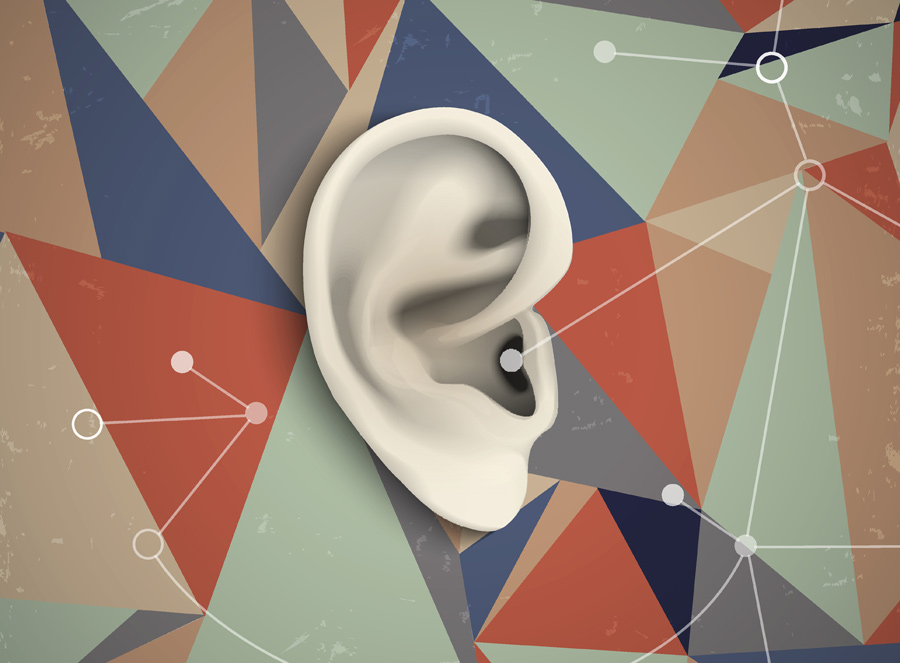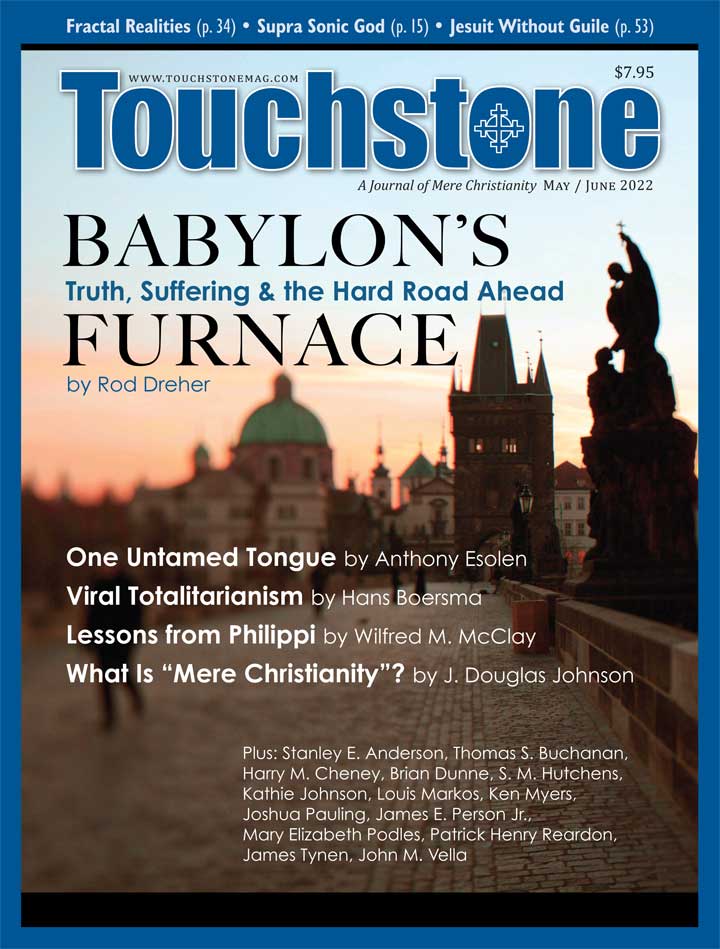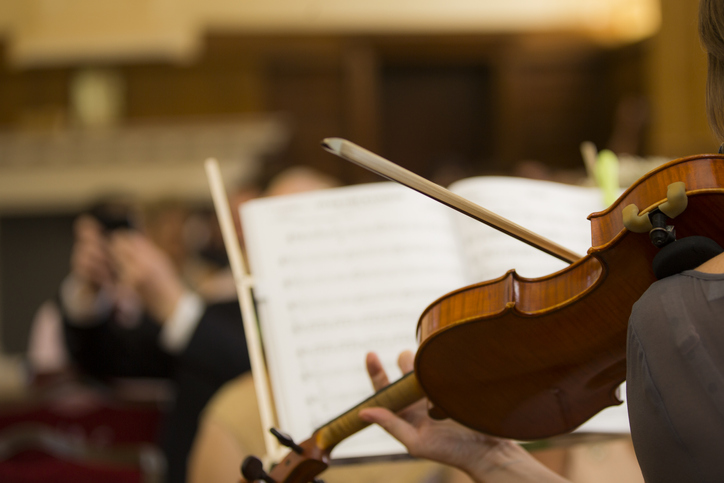Supra Sonics
on God's World Through the Ears of a Movie Sound Editor
"This is my father's world, and to my listening ears, all nature sings, and round me rings the music of the spheres." —Maltbie Davenport Babcock
The ear is a wondrous creation, God's own Rube Goldberg contraption with a drum, a hammer, and an anvil for percussion and a whole string section of finely tuned hair follicles that interpret the rhythm and make sense of the beat. And, oh, what a cacophony! Imagine if you could hear a recording of every sound that has passed through this miraculous widget in your lifetime: the carefree laughter of your children, the shouts of recrimination and anger, the happy chatter of family around the Thanksgiving table, the muted weeping of the bereaved at a funeral—a symphony of emotion where a mournful adagio is followed by a rousing chorus of joy, a soundtrack rich with God's love, grace, and mercy.
I find the modern recording device to be (almost) equally wonderful. Based on the same principle as the ear, a drum-like membrane (the microphone) moves sympathetically to incoming vibrations, which are translated into weak electrical signals. These are then boosted by an amplifier that causes a larger membrane (the speaker) to accurately duplicate the vibrations picked up by the microphone and turn them back into a recognizable facsimile of the original source audio. We have lost our sense of wonder if we don't find that utterly amazing.
The Emotive Power of Sound
With these two inventions—the microphone and the speaker—I have made my living for the past thirty-plus years as a motion-picture sound editor. Now, as a university professor, I try to instill in my students an appreciation for the emotive power of sound.
Almost everything you hear in a modern movie or TV show has been added after the filming is completed. Everything from footsteps to gunshots, car crashes to kisses, has been meticulously selected to enhance the story. Our purpose is not necessarily to duplicate the exact sound an object would make. Emotion will almost always trump authenticity in search of human truth.
For example, a handgun is a highly machined tool that shouldn't make a noise when raised to a shooting position. Not so in film, where every movement of a weapon is accompanied by an ominous "click." We have used everything from a broken rifle to a doorknob to get this sound, and it is quite effective in conveying menace. Multiple sounds of varying strengths, frequencies, and origin are often layered, like a symphonious chord, for a single sound effect. The sound of Rocky punching his opponents, for example, contained fifteen or more elements for each punch, including explosions and car crashes.
Audio carries the emotion in a film. Images can certainly convey meaning, but ultimately, a gun is just a gun and "a kiss is just a kiss." Add a soaring musical score to that kiss, however, and the fate of the world is in the balance as Rick and Ilsa embrace in that backwater burg called Casablanca. The movies of Steven Spielberg would be greatly diminished without John Williams's ascendant scores. "Without John Williams," Spielberg has said, "bikes don't really fly, nor do brooms in Quidditch. There is no Force, dinosaurs do not walk the Earth. We do not wonder, we do not weep, we don't believe."
And, I might humbly add, without the sound of footsteps, the actors will appear to float. In post-production we have a process called "foley." On a sound stage, a "foley artist" will perform customized sound effects to a projected picture. Everything from footsteps to earthquakes is added to the film, and it is the performance aspect of this process that best captures the purpose of post-production sound: how does it feel? No matter what sound we are going for, before we push the record button, we invariably say: "Let's try it and see if it works." The right sound will bypass your defenses and touch something elemental inside of you. If the sound crew feels that emotional connection between picture and sound, then so will the audience.
A Place of Dissonance
I live my life acutely aware of the sounds that bombard my senses. The city of Orange is where we call home, with its urban forest, historically preserved downtown (the largest in California) and its old-fashioned plaza complete with a traffic circle and fountain. It is Mayberry—with good restaurants. But it's noisy. We live in the intersection of five freeways, and the sound of traffic is an incessant monotone. In one study, scientists found that city birds need to sing louder to be heard. This must certainly be true here in Orange, where the highways clash together in what is known locally as "the Orange Crush."
Nevertheless, the voices of our avian friends ring through, whether the insistent call of the ravens, the ebullient song of the mockingbird, or the squawks of the wild parrots that call Orange home. But this is a place of dissonance, of Harleys and sirens and eighteen-wheelers, that is only attenuated when the hot Santa Ana winds blow in from the desert and the ubiquitous palm trees sing in protest. "Oh for the wings of a dove, to fly away and find rest. How I would take my flight and make a new home in the desert" (Ps. 55:6–7).
So one noisy day, I decided to take a pilgrimage to God's great foley stage to hear clearly the work of the original Sound Editor. I hopped on those freeways and headed to the source of those winds, driving out of San Bernardino, through the Cajon Pass to the high desert of California. Take the off-ramp for CA 395, pass through the fast-food gauntlet of Adelanto, and you are rolling through the Mojave Desert—the beginning of what Mary Austin called "the land of little rain," where it is quiet enough to hear God's ongoing post-production symphony of nature: the eternal Foley Artist creating a soundtrack of pure beauty.
The Arid Land Sings to God
Turn on any of the dirt roads that head out into the Mojave and drive awhile (not too far—you could die). Switch off your engine and listen: an immense silence, similar to being submerged in water, presses on the ear, with an occasional insect soloist and a dry mesquite bush rattling in the breeze. Or stand beneath the power lines and hear a drone like an aboriginal digeridoo.
But this is just the matinee. At night, the Milky Way bisects the sky, so full of burning lights one feels the need to squint. One night, standing beneath this splendor, I swear I heard them sizzling, a low hissing sound. Impossible, but then again, God asked Job, "Where wast thou when the morning stars sang together?" Ever wonder what stars sound like when they are singing? NASA discovered that celestial bodies emit radio signals that can be converted to sound waves. Go to the website (nasa.gov/vision/universe/features/halloween_sounds.html) and listen to the music of the spheres. Imagine what this planetary choir sounds like to God, the
composer!
Closer to the ground, the ubiquitous coyote pack sings its chorale. At the entrance to the campground in Death Valley, we once saw a sign announcing the current score: "Coyotes 9–Pets 0." At night they arrive looking for an easy supper—Fido is on the menu. Unlike the stately wolf with its poetic howl, this yapping bunch sounds like a pack of canine teenagers up to no good: a perfect choice by a master sound designer.
Continue north on CA 395 past the mystic blue of Little Lake (and the superfluous sign that reads, "Begin Scenic Drive") and you enter "the deepest valley." Situated between the Eastern Sierra range, crowned by Mt. Whitney—the highest point in the contiguous United States—and the White/Inyo Mountains in the East, anchored by White Mountain itself, a mere 200 feet shorter than its cousin in the Sierra, and you've entered Owen's Valley. It is here that Mary Austin penned her classic novel, The Land of Little Rain. Here also Father John Crowley, the Desert Padre, ministered to a flock that stretched from the lowest point in the U.S.—Death Valley—to the highest, where he famously celebrated Mass on the peak of Mt. Whitney.
It's dry here: precipitation from the Pacific Ocean stops at the imposing barrier of the Sierra range. Indeed, the parched Inyo mountains must look to a visitor from the verdant eastern U.S. like the tailings from a brimstone mine in hell. But I appreciate their candor; they are not clothed with a mantle of green pine, but with the plain detritus of dormant volcanos.
"In the rustling grass, I hear him pass. He speaks to me everywhere" (Babcock). For all its aridity, life is abundant here and the land sings praise to God if you stop long enough to listen. Here, the heavenly Sound Designer plays a muted theme: the tinkling xylophone sound of Owen's River, the wind moaning through the sea of sage and the sparse cottonwood trees. It's a voice that calms the soul, a chamber orchestra playing in the stillness.
In some places just off the highway, the granite walls of the Sierra ascend without gradation to 11,000 feet, with only the volcanic red cinder cones at their feet. The changing light of each season—each day, really—molds the crags and crevices into a mutable wonder like a fresh creation of the Master's hand. I'm a bit of a literalist and I believe the Prophet Isaiah when he says, "The mountains and the hills shall break forth before you into singing" (Is. 55:12). Someday I expect to stand on the floor of this "deepest valley" and hear the stone keep of the Eastern Sierra shout out the Creator's praise.
Where the Whole Band Plays
Despite being a descendant of hard-rock miners who toiled in the depths of these mountains and the arid hills of Nevada, I gratefully leave the heat of the high desert for the sweet coolness of higher elevation. I leave behind the Doppler zing of mosquitoes flying recon past my ear for the serenity of the Jeffrey pine choir harmonizing in the wind. "This is my father's world, I rest me in the thought of rocks and trees, of skies and seas, his hands the wonders wrought" (Babcock).
I once overheard a resident of Mammoth Lakes—a resort town at 8,000 feet elevation—complaining of the toll the extreme weather takes on homes there. His friend replied, "Well, that's the price we pay for living in paradise." A bit of a theological leap to be sure, but standing in the forest by an alpine lake and hearing the wind strum the trees like so many stringed instruments, one feels that, maybe, just beyond the next pass, is the throne of God. Some days, as the jet contrails multiply, the sky looks like a Jackson Pollock painting—stark white on bright blue. Here, the stunning landscape has a sublime score.
If the Mojave is home to the Master's soloists, here in the heights the whole band is playing. Stand on Minaret Summit Overlook as the Conductor lowers his baton and the wind rises. Deep bass notes ascend from Reds Meadow Valley below, and the nearby pines on the plateau answer with a higher pitch, like a violin section playing in blessed harmony.
There is a comedic element to all this, as well. Lovely tranquility is interrupted by a raucous choral section like something out of a Gilbert and Sullivan romp: the indignant bark of a Douglas squirrel, a kvetching Steller's jay, the acquisitive squawk of a raven, or the exquisite call of the meadowlark. Unlike his human counterparts, the supreme Sound Editor creates his own instruments and fills the forest with a divine sense of humor.
Back in town, I sit on the porch and listen to the sound of human activity contributing to this serene soundtrack. God understands the power of single sounds and is judicious in their use: the morning echo of a barking dog, the raucous snarl of a chainsaw, the shout of a child playing in the woods.
The Most Versatile Instrument
And there it is. Having sampled God's soundtrack from the desert to the mountains, I hear his most versatile instrument: the human voice, an instrument both awe-inspiring and altogether frightening in its range. With it we "bless God and curse Man" and set fire "to the whole wheel of creation" as Brother James admonishes us in his epistle.
In movies, the actor's voice is always prominent, coming right out of the center speaker with all other sounds subordinate. We use ADR (Automated Dialogue Replacement) to re-record the actor's dialogue to ensure clarity. We hire "walla groups"—union voice actors—who put words in the mouths of the chattering background extras, because they, in fact, are merely moving their lips in pantomime. Dialogue reveals the plot, expresses love and hate, accusation and praise. In the beginning there is the word on a page, and the performer brings life to those words. Likewise, the Word of God brings life to his cast of believers, for, as Shakespeare said, "All the world's a stage and all the men and women merely players." And that Word became flesh and spoke with a voice like ours. All else is background ambience to this wonder of creation.
From the ragged, deeply human voices of Emmy Lou Harris and John Prine to the perfect pitch of Luciano Pavarotti and Kathleen Battle, we hear an echo, as through an eternal forest, of the Voice that spoke creation into existence. Eternal life is on the tips of our tongues. And damnation. "By your words you shall be condemned," but "with the mouth, confession is made unto salvation." Filmmakers tell their stories with picture and sound. As does God: "For the heavens declare the glory of God; and the firmament sheweth his handywork. . . . There is no voice nor language where their voice is not heard."
"He that hath ears to hear, let him hear."
Harry M. Cheney worked as a sound editor in Hollywood for thirty years and teaches at Chapman University’s Dodge College of Film in Orange, California. He and his wife attend Calvary Chapel in East Anaheim.
subscription options
Order
Print/Online Subscription

Get six issues (one year) of Touchstone PLUS full online access including pdf downloads for only $39.95. That's only $3.34 per month!
Order
Online Only
Subscription

Get a one-year full-access subscription to the Touchstone online archives for only $19.95. That's only $1.66 per month!
bulk subscriptions
Order Touchstone subscriptions in bulk and save $10 per sub! Each subscription includes 6 issues of Touchstone plus full online access to touchstonemag.com—including archives, videos, and pdf downloads of recent issues for only $29.95 each! Great for churches or study groups.
Transactions will be processed on a secure server.
more on music from the online archives
more from the online archives
calling all readers
Please Donate
"There are magazines worth reading but few worth saving . . . Touchstone is just such a magazine."
—Alice von Hildebrand
"Here we do not concede one square millimeter of territory to falsehood, folly, contemporary sentimentality, or fashion. We speak the truth, and let God be our judge. . . . Touchstone is the one committedly Christian conservative journal."
—Anthony Esolen, Touchstone senior editor











